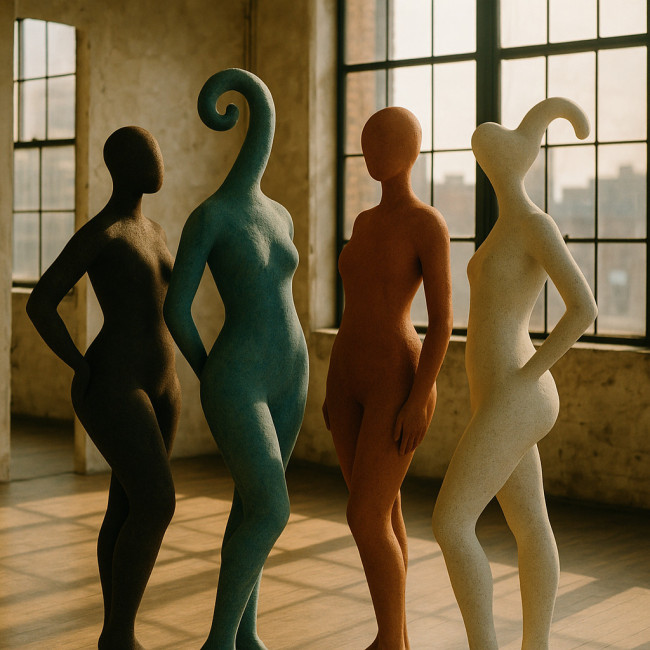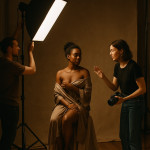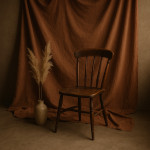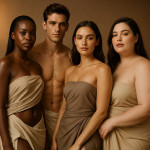Inclusive posing guidance: elevate body-positive narratives in nude imagery
Ready to create nude photographs that celebrate every body with confidence and respect? This guide delivers inclusive posing techniques, communication cues and on-set workflows that place body-positivity at the core of your artistic practice—while keeping everyone safe, empowered and creatively fulfilled.
Why inclusive posing matters more than ever

This illustrative image captures a group of four very different bodies—a curvy Black woman, a slender older man with vitiligo, a muscular trans-masc amputee and a pregnant Asian non-binary sitter—standing side by side in warm window light. Their relaxed postures, unretouched skin textures and mutual eye contact instantly communicate solidarity, self-acceptance and quiet pride. Let the scene anchor the reader's imagination before exploring the social, psychological and commercial impacts that inclusive posing can generate within contemporary nude photography.
Nude imagery shapes cultural perceptions of worth, desirability and self-acceptance. When poses emphasise only narrow beauty standards, viewers absorb a silent message: “Only some bodies deserve the spotlight.” By embracing inclusive posing you:
- Normalise diverse body types, ages and abilities.
- Reduce the performance anxiety many sitters feel during a nude session.
- Attract a broader audience, including clients focused on representation and ethical marketing.
- Strengthen your professional credibility—especially when paired with ethical shooting guidelines and transparent consent protocols.
The pillars of body-positive posing
1. Collaborative preparation
One-way direction often reproduces power imbalances. Instead, schedule a pre-shoot call to co-create a pose reference board. Invite sitters to pin images that resonate with how they wish to be seen. Ask:
- “Which angles feel empowering for you?”
- “What stories do you want these photos to tell about your body?”
- “Are there areas you'd prefer to downplay or highlight?”
By the shoot day, you both share authorship of the visual narrative, reducing surprises and elevating trust.
2. Language that empowers
Replace corrective commands (“Suck in”, “Hide that”) with affirming action verbs. Examples:
- Supportive cue: “Lift through the sternum to show strength.”
- Inclusive cue: “Let the curve of your hip lead the eye—beautiful.”
Reinforcement phrases like “Yes, that's powerful” validate the sitter's body as it is—not as it “should be.”
3. Pose families that celebrate variety
Build a mental library of inclusive poses grouped by intention:
| Pose family | Best for | Key direction |
|---|---|---|
| Grounded power | Plus-size, curvy, pregnant bodies | Seated on the floor, knees apart, shoulders back |
| Fluid lines | Older sitters & mobility-limited models | Recline on cushions, elongate hands along thighs |
| Dynamic stretch | Athletic or amputee talent | Weight on one limb, other limb extended into frame |
| Sensory embrace | All genders exploring vulnerability | Arms cross torso, fingertips lightly trace skin |
4. Lighting that flatters every skin tone
A beautiful pose collapses if harsh lighting exaggerates texture or colour shifts. Review our dedicated guide on lighting setups that flatter all skin tones to lock in inclusive exposure settings before fine-tuning pose direction.
5. Continuous consent checkpoints
Body-positive posing is inseparable from enthusiastic consent. Build micro-checkpoints:
- Before wardrobe changes.
- Before each new pose that exposes areas not previously discussed.
- Immediately after any request to adjust body parts.
Document verbal approvals on an audio recorder; integrate them later with your privacy-first model release.
Step-by-step pose workflow on shoot day
- Warm-up stretch (5 min)
Encourage gentle shoulder rolls, spine twists and deep breaths. This loosens muscles and grounds the sitter in their body. - Mirror rehearsal (3 min)
Stand beside the model facing a full-length mirror. Demonstrate two or three body-positive poses together. It feels less clinical and instantly breaks power hierarchy. - Guided exploration (10 min)
Turn away from the mirror, maintain camera down to let the sitter move freely. Capture candid frames that reveal natural gestures. - Refined hero shots (20 min)
Switch to tethered capture. Review images collaboratively on screen, adjusting micro-angles to avoid “pinched” skin folds or unintended distortion. - Closing affirmation (2 min)
Share immediate positive feedback: “These frames radiate confidence and authenticity.” The model leaves feeling valued, which increases future referrals.
Inclusive posing tips by body focus
Curves and rolls
Instead of hiding soft areas, sculpt them with side lighting. Ask the sitter to place a hand gently on the fold to highlight its sensual contour.
Scars, stretch marks, tattoos
Turn perceived “imperfections” into narrative anchors by tilting the torso slightly toward key light and letting texture pop. Offer macro crops so the sitter decides later what to publish.
Mobility devices & prosthetics
Feature canes, wheelchairs and prosthetics as integral design elements. Angle the device into leading lines; never crop it unless the wearer requests. This visual respect mirrors the approach in inclusive spatial design principles where assistive tools are celebrated rather than hidden.
Gender-inclusive cues
Avoid traditionally “feminine” or “masculine” hand placements unless specifically requested. Instead, direct posture based on the emotion you both aim to convey—strength, curiosity, serenity.
Narrative-driven composition
When posing celebrates body diversity, composition should reinforce the story. Consider:
- Negative space to frame limb difference.
- Layered foregrounds (fabric drape, plants) to hint at privacy while still honouring nudity.
- Eye-line focus to shift narrative from objectification to human connection.
Post-production without erasure
Retouching must not undo your inclusive efforts. Follow these checks:
- Keep skin texture; remove only transient blemishes.
- Match saturation across varied skin zones rather than applying blanket smoothing.
- Retain natural folds and cellulite; these visual truths affirm authenticity.
For creative direction beyond basic colour grading, see the trend breakdown in 2025 fine-art nude trends.
Delivering a body-positive client gallery
Curate the gallery chronologically so sitters revisit their posing journey from timid first frames to confident closing shots. Include a private proofing section where they can flag any image that undermines their comfort.
Many clients discover inclusive photographers via specialised directories; make sure your portfolio on artistic nude photographer listings showcases these body-positive principles prominently.
Inclusive posing quick-reference checklist
- Co-create pose board pre-shoot.
- Use affirmative, non-corrective language.
- Guide through pose families suited to their body story.
- Employ skin-tone-sensitive lighting.
- Check consent before each exposure change.
- Celebrate scars, rolls, aids and age markers.
- Retouch minimally; never reshape bodies.
- Offer sitter veto power during gallery delivery.
Interactive knowledge break
FAQ
- How can I help a shy first-time nude sitter feel comfortable?
- Begin with clothed or partially draped warm-up poses, keep conversation flowing, and show them tethered previews so they see flattering results early.
- Is it acceptable to suggest poses from traditional fashion imagery?
- Yes, but adapt them: replace restrictive “hourglass” cues with neutral spine alignment and open limb positioning that works for any body shape.
- What if a client requests heavy retouching that contradicts body-positive ethics?
- Explain your philosophy, offer light skin-tone correction, and provide resources that celebrate natural features. If misaligned, consider declining the brief.
- How do I price an inclusive nude session?
- Factor standard creative fees plus time for pre-shoot consultations, pose board collaboration and post-session veto rounds. Transparently itemise these steps in your quote.
- Where can I showcase a body-positive nude portfolio?
- Upload to niche directories like Artfolio's artistic nude category, social platforms with consented hashtags, and galleries that promote inclusive fine art.
Next steps: turn guidance into practice
Implement these inclusive posing foundations in your next shoot and refine them with each collaboration. For extra credibility, pair today's lessons with expertise in clear client briefing templates. Your portfolio will not only stand out—it will actively reshape how society views nude bodies.
Call to action: Schedule your first body-positive concept call this week and invite a diverse sitter to co-build the pose board. Your journey toward inclusive artistry starts now.











